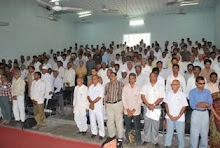Times of India: Nagpur: Monday, 22 September 2014.
Six days after TOI reported 40 tigers missing in
Maharashtra, based on information received under the RTI Act, the forest
department on Saturday tried to explain away the discrepancies. It termed the
comparison of figures as 'imprudent', citing big difference in methodology of
data collection.
A department release said there is no drop in
tiger numbers. It tried to play down the figures by claiming differences in
methodology, without giving any specifics. In fact, the release does not talk
about the actual methodology at all.
The department now seems to claim that the
Wildlife Institute of India (WII) methodology for tiger estimation in PA areas
and its landscape in 2010 is not comparable to the Phase IV (camera trap)
exercise started since 2012 in tiger reserves. But this does not explain how
forest minister Patangrao Kadam claimed in the legislative assembly on June 10,
2014, that there were 200 tigers in Maharashtra till 2013 based on the same
figures.
In Melghat, the tiger population appears stagnant
between 2006 and 2010 at 29-32, despite the area of estimation increasing by 515
sq km. In Phase IV too the number was same. "How is it possible? Evidence
shows rampant poaching in Melghat," say wildlife experts.
The department says in 2010, WII estimated tiger
numbers in Nagzira as 20, 21 in Sahyadri and 12 in Bor and its landscape. But
experts working in the field for 30 years are surprised at these figures.
However, the reports do not mention where the estimation was done, and experts
say WII appears to have simply extrapolated tiger numbers.
Leading wildlife expert K Ullas Karanth had
pointed out after the 2010 estimation report that the full process of how these
numbers were generated for individual tiger populations and landscapes has not
been made public in a scientifically acceptable manner.
Sources said that in 2014 four tigers have been
recorded in Bor, six in Navegaon-Nagzira tiger reserve (NNTR) and four in
Umred-Karhandla. These figures exclude cubs, which are not counted.
The Phase IV exercise was done only in tiger
reserves. However, former PCCFs SK Khetarpal and SWH Naqvi told TOI that Phase
IV was carried out in tiger bearing PAs, including Bor and Nagzira, which were
not tiger reserves then.
"All figures in these areas and their
landscapes of 2010 were either fudged or tigers killed by poachers later. The
confusion will be cleared after WII announces the 2014 figures," said
sources. They added that Nagzira and its landscape never had 20 tigers. So is
the case with Bor and Sahyadri. Even tourists complained about poor sightings
in Nagzira over the last two years.
The department, however, claimed that the figures
have not dropped. This is surprising since poaching was rampant in 2012-13.
Tiger skin and body parts trader Sarju Bagdi admitted that he procured five
tiger skins, but other poachers trafficked over 20 skins from here. Poachers
have admitted to killing 15 tigers. At least 10-12 offences have also been
registered.
Lid blown off Umred-Karhandla numbers
It is not about jugglery of figures in Bor,
Nagzira or Sahyadri only. Umred-Karhandla was notified on June 29, 2012. TOI
has a copy of the proposal which says that as per estimation the area had 11
tigers. Experts ask where have tigers gone. In 2013, there were three tigers
and in 2014 there are four. The new entrant is male tiger Jai, which moved a
long distance as there was no rival. The officials also cannot say whether
tigers have migrated. But arrested poachers have confessed to poaching tigers
in Umred-Karhandla.














































































